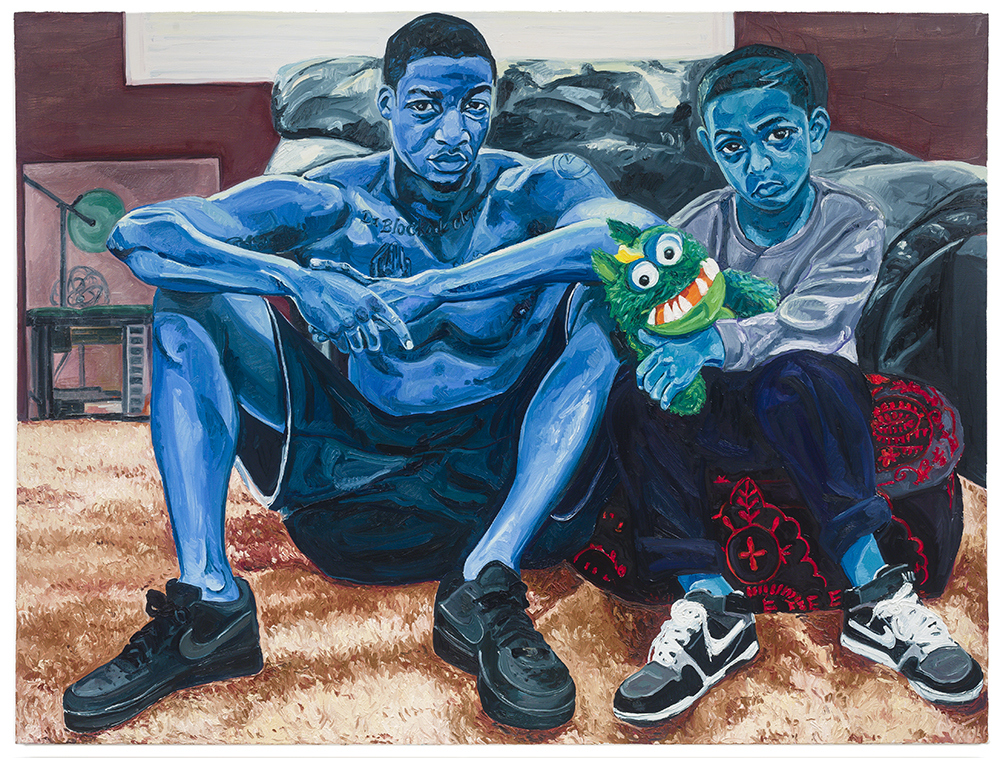On Sept. 29, Jordan Casteel’s “Returning the Gaze,” an exhibition that portrayed “often overlooked members of society,” opened at the Cantor Arts Center. Casteel’s portraits featured people of color with the aim of increasing the visibility of these groups. I had the privilege of attending the press preview on the Friday before the exhibition opened.
Aleesa Alexander, the exhibition’s curator, introduced us to Casteel, the sharply-dressed, beaming virtuoso behind “Returning the Gaze.” Before guiding us through the hall, Casteel spoke briefly about how she wanted to preserve the integrity of the exhibition during its transition from Denver to Stanford, and also about her experience with art, which included her graduate education at Yale and her teaching career at Rutgers University.
The space was invitingly open and white, with warm hardwood floors and cool blue accent walls. Casteel first directed our attention to the two smallest paintings in the room, one entitled “Mom Hand,” the other entitled “Mom.” It depicted a seated woman resting her head on her layered hands, which were draped over the back of a bench. She explained that these paintings anchored the exhibition in her home, the place where it all started.
On the wall opposite these paintings hung large canvases that explored male-to-male family relationships. Casteel elaborated upon “Miles and Jojo,” a painting of two boys with striking, other-worldly blue skin, explaining how she wanted to challenge people’s perception of her as an artist who painted only “Black” men. She wanted to push back against the preconceived notions that people carried when approaching a work of art that depicted Black men. She discussed how the Black male body was often criminalized, marginalized, demonized and victimized, and how she wanted people to see Black men the way she saw them: as tender, beautiful and vulnerable; as fathers, brothers and sons.
These themes continued into the next room of the exhibit where the “Visible Man Series” lived. The subjects of this series were nude Black men who looked out at the viewer, inviting startling eye contact that created a sense of intimacy. Many of the men were posed across bold floral couches, the robustness of their bodies accentuated by the flat patterns. Each man was accompanied by an object that held meaning to them, like a prayer candle or a picture of a loved one. The men pushed against the boundaries of the canvases that contained them; toes, elbows and foreheads were nearly grazing the edges.
As we moved into the next section, there was a shift in subject matter away from Black men and towards the people of Harlem, representing Casteel’s move to Harlem for her residency. Casteel recounted how someone once described her as a “landscape painter,” a remark that she instinctively disagreed with, but eventually came to realize had truth behind it. Her “landscape” was the neighborhood of Harlem — with its brick buildings, neon signs and cluttered storefronts — and the people that occupy it.
The final segment of the room represented where Casteel was headed. This symbol of forward motion was captured in candid portraits of people on the subway. One particularly captivating piece was “Lean,” which depicted a small child burying himself into the folds of his father’s jacket, one tiny hand clutching the man’s pant leg. The tender security of their embrace contrasted with the cold authority of a sign behind the boy that read “Do not lean on door.”
In this room were also portraits of people who Casteel knew personally. She became emotional talking about the late Yvonne from “Yvonne and James,” who she described as her “Harlem parents.” A video on the wall rolled a clip of Casteel stressing the importance of representing the living and people of color in portraiture, an art that predominantly featured “dead white people.” She wanted to make art for people who usually didn’t have the opportunity to visit museums.
After the rest of the press cleared out, I strolled through the exhibition one last time to fluidly experience it in its entirety. I was intrigued by the cool blue that connected the beginning, middle and end of the exhibition. When I asked Alexander about this choice, she explained to me how it stayed true to the Denver exhibition and also provided an immersive environment for the night paintings, like “Amina,” which captured the facade of a hair salon, plastered with the smiling faces of dozens of Black women. I found the blue to be calming and enveloping. It provided a serene backdrop against which the painted eyes of Casteel’s subjects could seize my entire focus. As they returned the viewer’s gaze, they were truly being seen.
Jordan Casteel’s “Returning the Gaze” will be on display until Feb. 2, 2020. The Cantor Arts Center is free for everyone and open every day of the week from 11 a.m. to 5 p.m (except Tuesdays, when they’re closed, and Thursdays, when they’re open until 8 p.m.). Additionally, Stanford students can attend Cantor’s “First Fridays,” when “on the First Friday of every month during the academic year, the Cantor is open late for art-making, music, and more.” It is free for anyone with an SUID.
Contact Dax Duong at daxduong ‘at’ stanford.edu.
